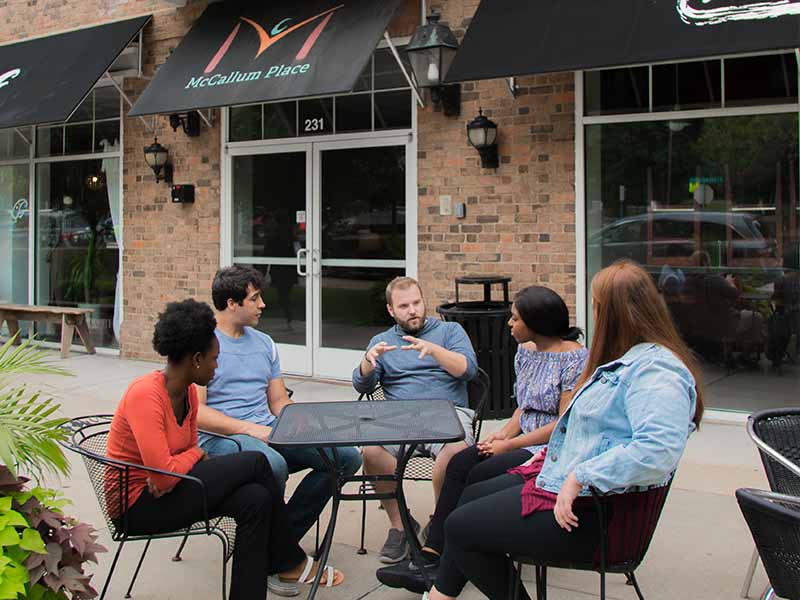by Caroline Leibman, MA, BC-DMT, NCC
Authentic Movement
Authentic Movement is another expressive therapy group which offers a self-directed form of moving that invites a deep attunement to and dwelling within the body. Patients are invited to close their eyes and follow movement impulses, as well as stillness that arises in the here and now. They are asked to focus on the sensations, emotions and images or thoughts that emerge naturally in their bodies. They may enter the movement impulses, or witness those impulses in stillness. Moving with eyes closed invites a deeper listening to the self, while encouraging the practice of mindfulness, being in the present moment, and maintaining self-awareness. A movement pathway offers a unique gateway for unconscious material in the body to be made visible, and therefore made more conscious, emerges.
A common example of this happens with resistant patients who are struggling to engage with treatment. In these situations a patient may be given a prop to work with, such as a large, soft, exercise ball. When presented with this they may reject the ball, toss it back to the group facilitator and verbalize, “This is stupid.” In doing this the patient is inadvertently opening a door for therapy and expressing, through the body and movement, the anger that is pent up inside. An experience clinician will utilize this opportunity to help the patient become more skilled at expressing emotions and making mind/body connections.
This process allows for a patient to come into a deeper awareness of what s/he is experiencing in the body on three levels: imagination/cognition, body sensation, and emotion. Again, the neocortex, limbic area, and sub cortical lower brainstem are accessed. Authentic Movement fosters a re-inhabiting of the body that encourages intimacy, compassion, and a deep appreciation of self as well as a gentle /loving way of being connected to the body that is not based on self-imposed restrictions. Authentic movement facilitates the re-experience of the sacred/spirit found in the body, which is often eclipsed by the eating disorder. This form invites an increased awareness and expression of thoughts, feelings, and sensations related to the present moment that directly connects to themes in a patient’s eating disorder treatment and recovery.
Psychodrama
Psychodrama is an expressive therapy that allows for a patient’s inner world to be made more tangible. Whether one is the protagonist, a role player, or an audience member, psychodrama invites an action based experience that impacts all group members. Inner and outer worlds of the patients become clearer. Cognitions, belief systems, emotions, and the somatic, sensory level of experience are accessed not only by the protagonist for the group, but also for group members as well.
A frequent psychodrama exercise is to act out a feeling that contributes to the patient’s eating disorder by either having a role player or prop serve as a stand in for that emotion. In doing so, the patient can “see” the emotion (such as anxiety) more clearly and the next step of the psychodrama often dramatizes how the eating disorder behavior (also dramatized through a person or prop) comes in to relieve or mask that uncomfortable emotion. This increases mindfulness and open doors for further exploration in therapy.
Role players, role doubles, and peer coaches allow for a wide choice of active involvement for all group members. Basic theatre skills like role/character playing, character improvisation, role amplification, and story re-enactment allow for the drama of the protagonist to unfold from beginning to completion. Techniques like “role-reversing” and the “empty chair” promote the deepening of the psychological material and greater understanding of the patient’s issues. Appropriate safety and containment are also maintained.
Psychodrama group highlights internal and external family systems — the roles and dynamics of these systems. Psychodrama themes can include the genesis of the eating disorder and what the patient needs for healing. Psychodrama invites “dialogues” with the eating disorder to problem solve, quell symptoms, and enhance self-understanding. This therapy also allows for emotions stored in the body to be released safely; the opportunity for movement, sounds and words to be expressed safely in the here and now. It also allows for corrective experiences for posture and gesture that invite self-empowerment. In addition, Psychodrama can also illuminate distorted self-belief systems, intergenerational lies, and implicit family rules and their contribution to eating disordered patterns of behavior.
This is an exciting time as research in neuroscience is advancing our understanding of the role of the triune brain in engaging the mind and body for balance and integrative healing. It is also exciting to be a part of the ever-evolving field of expressive arts therapies and their potent healing benefits for our patients struggling with eating disorders. We are confident that our expressive therapy groups at McCallum Place and Cedar Springs Austin are timely and effective. They offer healing and a greater chance for a lasting recovery.
Caroline Leibman is a board certified dance/movement therapist and a nationally certified counselor who holds an MA in Education from Washington University in St. Louis. She completed her graduate work in Dance/Movement Therapy as well as a Professional Diploma in Dance and Movement Studies at the Laban Centre, London, England. She trained in Authentic Movement at the Authentic Movement Institute in Berkeley California, and with Janet Adler, PhD. Caroline offers a blend of verbal and body-oriented therapies integrating Jungian thought, creative arts therapies, mindfulness, and spiritual practices to promote healing. She has a background in working with issues of trauma, eating disorders, depression/loss, and anxiety.









